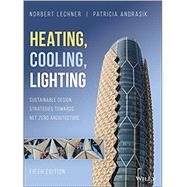The essential guide to environmental control systems in building design
For over 25 years Heating, Cooling, Lighting: Sustainable Design Strategies Towards Net Zero Architecture has provided architects and design professionals the knowledge and tools required to design a sustainable built environment at the schematic design stage. This Fifth Edition offers cutting-edge research in the field of sustainable architecture and design and has been completely restructured based on net zero design strategies. Reflecting the latest developments in codes, standards, and rating systems for energy efficiency, Heating, Cooling, Lighting: Sustainable Design Strategies Towards Net Zero Architecture includes three new chapters:
- Retrofits: Best practices for efficient energy optimization in existing buildings
- Integrated Design: Strategies for synergizing passive and active design
- Design Tools: How to utilize the best tools to benchmark a building's sustainability and net zero potential
Heating, Cooling, Lighting: Sustainable Design Strategies Towards Net Zero Architecture is a go-to resource for practicing professionals and students in the fields of environmental systems technology or design, environmental design systems, construction technology, and sustainability technology.









